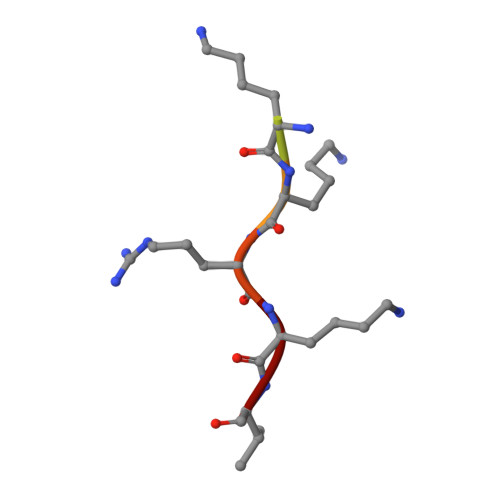Structure of Importin-alpha from a Filamentous Fungus in Complex with a Classical Nuclear Localization Signal.
Bernardes, N.E., Takeda, A.A., Dreyer, T.R., Freitas, F.Z., Bertolini, M.C., Fontes, M.R.(2015) PLoS One 10: e0128687-e0128687
- PubMed: 26091498
- DOI: https://doi.org/10.1371/journal.pone.0128687
- Primary Citation of Related Structures:
4RXH - PubMed Abstract:
Neurospora crassa is a filamentous fungus that has been extensively studied as a model organism for eukaryotic biology, providing fundamental insights into cellular processes such as cell signaling, growth and differentiation. To advance in the study of this multicellular organism, an understanding of the specific mechanisms for protein transport into the cell nucleus is essential. Importin-α (Imp-α) is the receptor for cargo proteins that contain specific nuclear localization signals (NLSs) that play a key role in the classical nuclear import pathway. Structures of Imp-α from different organisms (yeast, rice, mouse, and human) have been determined, revealing that this receptor possesses a conserved structural scaffold. However, recent studies have demonstrated that the Impα mechanism of action may vary significantly for different organisms or for different isoforms from the same organism. Therefore, structural, functional, and biophysical characterization of different Impα proteins is necessary to understand the selectivity of nuclear transport. Here, we determined the first crystal structure of an Impα from a filamentous fungus which is also the highest resolution Impα structure already solved to date (1.75 Å). In addition, we performed calorimetric analysis to determine the affinity and thermodynamic parameters of the interaction between Imp-α and the classical SV40 NLS peptide. The comparison of these data with previous studies on Impα proteins led us to demonstrate that N. crassa Imp-α possess specific features that are distinct from mammalian Imp-α but exhibit important similarities to rice Imp-α, particularly at the minor NLS binding site.
Organizational Affiliation:
Departamento de Física e Biofísica, Instituto de Biociências, Universidade Estadual Paulista, UNESP, Botucatu, SP, Brazil.















